Oxmanswold
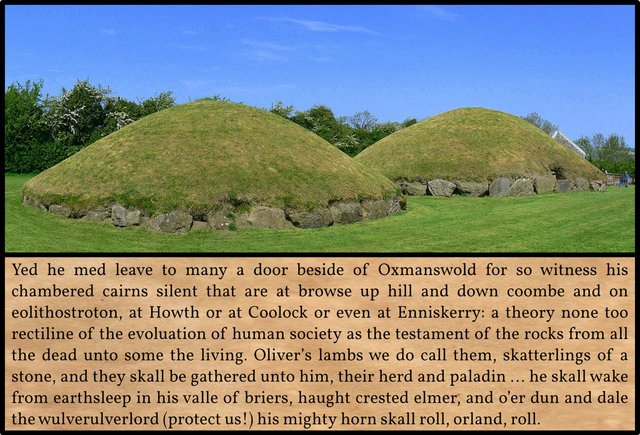
The last ten pages of Chapter 3 of James Joyce’s Finnegans Wake comprise an episode known as The Battery at the Gate, in which HCE suffers a sustained assault at the hands of an outsider. The final three paragraphs can be read as a short coda to this episode. HCE’s attacker has departed, leaving his hapless victim cowering alone in his hideout. But throughout this chapter HCE has been identified with his own attacker:
A striking feature of this chapter is its tendency to let the figure of the hero and his antagonists become merged. ―Campbell & Robinson 78
From this perspective, the departure of the latter in the direction of the deaf-&-dumb institute can be interpreted as HCE’s own death. His place of refuge is now his tomb. The gist of this paragraph, as FWEET puts it, is:
he is gone―until he awakes again
First-Draft Version
As we have seen, the final four paragraphs of this chapter were additions to the first draft, which concluded with the bullocky proceeding in the direction of the deaf-&-dumb institute. When an early draft of the chapter was published in the third issue of transition in June 1927, only the second and fourth of these paragraphs had been added. The former read as follows:
Yet he made leave to many a door beside of Finglas wold for so witness his chambered cairns silent that are at browse up hill and down coombe and on eolithostroton, at Howth or at Coolock or even at Enniskerry. Oliver’s lambs we do call them and they shall be gathered unto him, their herd and paladin, in that day hwen he skall wake from earthsleep in his valle of briers and o’er dun and dale the Wulverulverlord (protect us!) his mighty horn skall roll, orland, roll. ―Jolas & Paul 49–50
For the final version, Joyce added several more allusions to this early draft, while leaving the basic gist of the paragraph unchanged. The published version differs slightly from that in Restored Finnegans Wake. For the most part, Rose & O’Hanlon have reordered some of the clauses. The only significant difference between their version and the first edition is the omission of the words a cloudletlitter after chambered cairns.
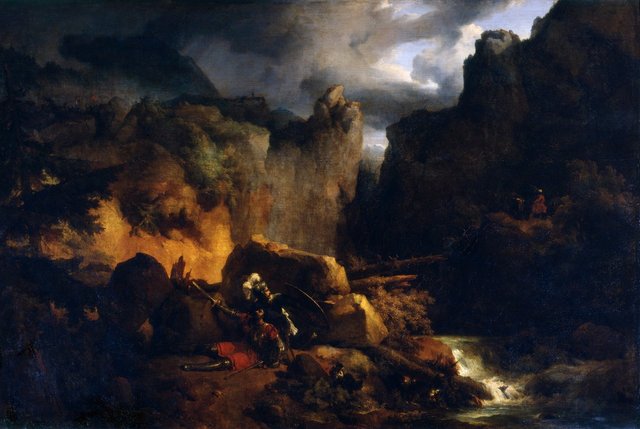
Charlemagne’s Paladins
This paragraph contains a few allusions to Charlemagne’s Paladins or Twelve Peers, the leading members of the Holy Roman Emperor’s court. These allusions all belong to the first draft. Joyce never added to them:
Charlemagne was endowed with the good and bad qualities of the epic king, and as in the case of Agamemnon and Arthur, his exploits paled beside those of his chief warriors. These were not originally known as the twelve peers famous in later Carolingian romance. The twelve peers were in the first instance the companions in arms of Roland in the Teutonic sense. The idea of the paladins forming an association corresponding to the Arthurian Round Table first appears in the romance of Fierabras. The lists of them are very various, but all include the names of Roland and Oliver. The chief heroes who fought Charlemagne’s battles were Roland; Ganelon, afterwards the traitor; Turpin, the fighting archbishop of Reims; Duke Naimes of Bavaria, the wise counsellor who is always on the side of justice; Ogier the Dane, the hero of a whole series of romances; and Guillaume of Toulouse, the defender of Narbonne. ―The Encyclopædia Britannica (Eleventh Edition) 5:895
- Oliver’s lambs Oliver (French: Olivier) was Roland’s closest friend. According to Le Chanson de Roland, he died fighting alongside Roland at Roncevaux. Oliver’s lambs was an ironic nickname for Oliver Cromwell’s troops, who ravaged Ireland in the 1650s.
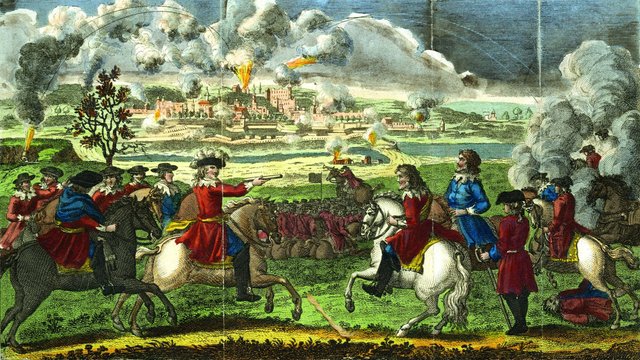
their herd and paladin the Twelve Peers (French: douze pairs) of Charlemagne were also known as the Paladins, a term believed to derive from Rome’s Palatine Hill. Our word palace is of the same etymology, so paladin originally meant of the palace, implying that one so-called was a prominent member of the royal court. Although the word was originally applied specifically to Charlemagne’s Twelve Peers, in time it became a general synonym for knight errant. Here, the word herd means shepherd or herdsman, referring back to Oliver’s lambs.
the Wulverulverlord (protect us!) Here, it is the wolf who protects us from the lambs.
- Danish: ulv, wolf.
- overlord
his mighty horn skall roll, orland, roll In Le Chanson de Roland, Roland commands the rear guard of Charlemagne’s army, which is retreating from Spain over the Pyrenees. In the Pass of Roncevaux the Saracen ambush the rear guard. Although he and his troops are in dire staits, Roland is too proud to raise the alarm by sounding his great horn Oliphant. Only when all hope has fled does he finally relent and wind his horn. In Italy, Roland is called Orlando. This form of his name is better known from the comic epics Orlando Innamorato_ and Orlando Furioso by Matteo Boiardo and Ludovico Ariosto.
Danish skal, shall.
Roll, Jordan, Roll is a Negro spiritual from America’s deep south.
Roll on, thou deep and dark blue Ocean―roll! Lord Byron, Childe Harold’s Pilgrimage 4:179
Toll! Roland, toll! Theodore Tilton, The Great Bell Roland. This poem celebrates the famous bell in Ghent, Belgium, which was alluded to earlier in this chapter (RFW 045.23).
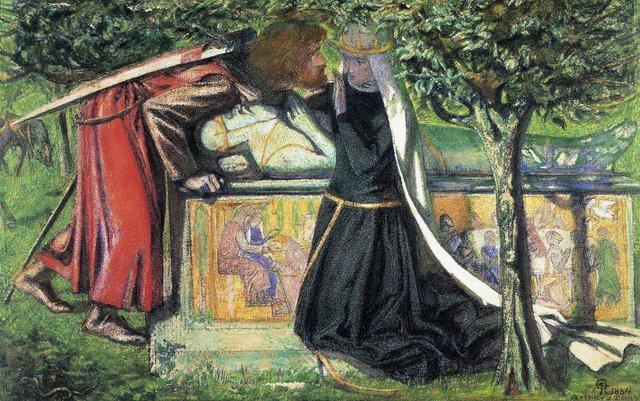
These Carolingian elements are complemented by a few Arthurian allusions:
hven, same the lightning lancer of Azava Arthurhonoured Gwenhwyfar or Guinevere, Lancelot and Arthur, the primary love-triangle of Arthurian legend. Another Arthur―Wellesley, later Duke of Wellington―clashed with French troops on the banks of the Azava river in Salamanca, Spain, during the Peninsular War (25 September 1811).
same the save the, meaning except for, were it not for.
lost leaders live! the heroes return! ... he skall wake from earthsleep Arthur was Rex Quondam Futurusque Rex: The Once and Future King. According to legend, he was not dead but merely sleeping, and he would one day awaken when his horn is sounded. Similar legends are recounted in relation to many other heroes, including Finn MacCumhail, who is also present in this paragraph:
as nubilettes to cumule Cumhall was Finn’s father. The cloudy associations are in keeping with a common thread that has been running through this chapter: poor weather, leading to limited visibility.
some Finn, some Finn avaunt! Irish: Sinn Féin, Sinn Féin Amháin, Ourselves, Ourselves Alone, the political slogan of Irish Nationalists from which the Republican party took its name.
Loose Ends
Finally, let us tie up some loose ends.
Yed Volapük yed, yet. The last word of the preceding page was also borrowed from Johann Martin Schleyer’s constructed language Volapük: adyoe, adieu, goodbye. Schleyer was Catholic priest, who believed that God had instructed him to create an international language for the benefit of mankind.
Danish med liv, with life.
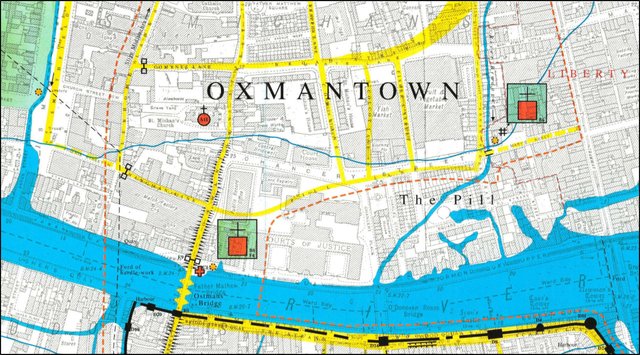
Oxmanswold Oxmantown was the settlement from which Dublin’s Northside grew. After the Anglo-Normans conquered Dublin in 1171, the native Scandinavians―Ostmen, or East Men―were expelled from the city and forced to settle on the other side of the Liffey.
chambered cairns ancient burial monuments, consisting of a cairn―a pile of stones―enclosing a chamber. Ireland’s passage graves―eg Newgrange, Knowth, Dowth, Loughcrew, Carrowmore―are chambered cairns.
a theory none too rectiline of the evoluation of human society An allusion to the Viconian Cycle of human history.
the testament of the rocks Hugh Miller, The Testimony of the Rocks. Miller was a Scottish geologist, who believed that that the earth sciences could be reconciled with the Biblical account of Creation―the testament of the rocks and the Old Testament.
skatterlings Danish skatter, treasure : Archaic scatterling, vagrant.
a stone ... as nubilettes to cumule ... Greenman Rise O In Finnegans Wake Shem & Shaun are often depicted as stem (green tree) and stone, while their sister Issy is a cloud overhead. Rose & O’Hanlon’s emendations have restored the close connection between these three elements. In the first edition, the reference to the children’s game Green Man Rise-O was displaced by several lines.
- Latin nubila, clouds, mists
- cumulus a large, white, puffy type of cloud
- O The Viconian Cycle again
And that’s as good a place as any to beach the bark of our tale.
References
- Joseph Campbell, Henry Morton Robinson, A Skeleton Key to Finnegans Wake, Harcourt, Brace and Company, New York (1944)
- David Hayman, A First-Draft Version of Finnegans Wake, University of Texas Press, Austin, Texas (1963)
- Eugene Jolas & Elliot Paul (editors), transition, Number 3, Shakespeare & Co, Paris (1927)
- James Joyce, Finnegans Wake, The Viking Press, New York (1958, 1966)
- James Joyce, James Joyce: The Complete Works, Pynch (editor), Online (2013)
- Danis Rose, John O’Hanlon, The Restored Finnegans Wake, Penguin Classics, London (2012)
Image Credits
- Chambered Cairns at Knowth, County Meath: © Dave Keeshan (photographer), Creative Commons License
- The Death of Roland: Achille Etna Michallon (artist), Musée des Beaux-Arts de Strasbourg, Public Domain
- Oliver cromwell at the Siege of Drogheda: Barlow (engraver), Public Domain
- Arthur’s Tomb: The Last Meeting of Lancelot and Guinevere: Dante Gabriel Rossetti (artist), Dallas Museum of Art, Dallas, Public Domain
- Oxmantown: H B Clarke, Ordnance Survey Ireland, Irish Historic Towns Atlas, © 2002 Royal Irish Academy, Fair Use
Useful Resources
- FWEET
- Jorn Barger: Robotwisdom
- Joyce Tools
- The James Joyce Scholars’ Collection
- FinnegansWiki
- James Joyce Digital Archive
- John Gordon’s Finnegans Wake Blog
- James Joyce: Online Notes
